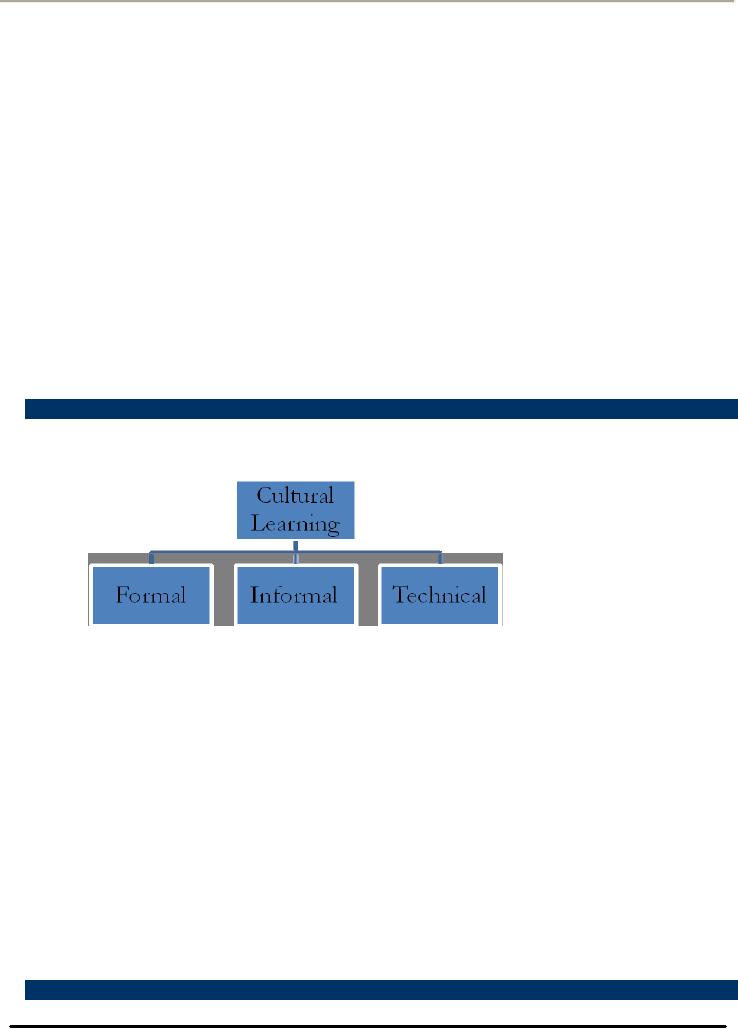 |

Consumer
Psychology (PSY -
514)
VU
LESSON
18
HOW
CULTURE IS LEARNT
ENVIRONMENTAL
INFLUENCES
Understanding
�
How
Culture is learnt
�
Three forms
of Culture Learning
Formal
Informal
Technical
�
Advertising
& Culture learning
Enhancing
Informal Culture Learning
Repetition
in Advertising
Movement
of Cultural meaning to consumer
goods
�
Enculturation
& Acculturation
�
Language
& Symbols
�
Rituals
Unlike
innate biological characteristics (e.g.
gender, skin, hair color, intelligence)
culture is learned. At an early
age
we
begin to acquire from our
social environment a set of
beliefs, values and customs
that make up our
culture.
1.
Three Forms of Cultural
Learning
Psychologists
and anthropologists have identified
three distinct forms of cultural learning.
A.
Formal Learning
Adults
and older siblings of the
family teach a young member
how to behave:
Please
shake hands with
uncle
Say
hi to aunty
Wash
your hands before
eating
Take
small bites
B.
Informal Learning
A
child learns primarily by
imitating the behavior of selected
others, such as family, friends
and TV heroes.
C.
Technical Learning
Teachers
instruct the child in an educational
environment about what should be done, how it should
be done and
why
it should be done e.g.:
Do
your homework every day to
learn the course or you will
fail
Work
hard
Pay
attention
Control
yourself, focus
Learn
discipline
2.
Advertising and Cultural Learning
62

Consumer
Psychology (PSY -
514)
VU
Advertising
can impact all three
ways of cultural learning.
Enhancing
informal cultural learning
Many
product advertisements enhance
informal cultural learning by providing the
audience with a model of
behavior
to imitate. This is especially true
for visible or conspicuous products
that are evaluated in public
settings
e.g.
designers clothing
Repetition
in Advertising
Repetition
creates and reinforces cultural
beliefs and values. Many
advertisers continually stress the
same selected
benefits
of their products. Certain product
advertisements may reinforce the benefits
that consumers want
from
the
product. They also teach the
consumers to expect the same benefits
from the product
category.
Movement
of cultural meaning to consumer
goods
Cultural
meaning moves from
culturally constituted world to consumer
goods to the end consumer
through
various
consumption related vehicles. For
example:
How
T-Shirts can identify cultural meaning
and identity for the
wearers
T-Shirts
as trophies (as proof of participating in
sports)
Self
proclaimed labels of belonging to a cultural
category
T-Shirts
can also be used as a means
of self expression
A
New York T-Shirt would be
worn by a person whop has
been to NY, consumers can
buy such a T-Shirt
from
a local retailer and create the
impression that they have
been to NY or else they can
show their affinity
for
the NY
3.
Enculturation
and Acculturation
Enculturation
Learning
of one's own culture is called
Enculturation. The process of
enculturation may be utilized to
position the
products.
Acculturation
The
learning of new or foreign culture is
called Acculturation. Too
many marketers contemplating
international
expansion
make the strategic error of
believing that if their products
are liked by the local
consumers then every
one
will like them. To overcome
such a narrow view marketers
must go through an acculturation process.
They
must
learn everything that is relevant about
the usage or potential usage of
their products and product
categories in
the
foreign countries in which they plan to
operate
4.
Language and Symbols
To
acquire a common culture the members of a
society must be able to
communicate with each other
through a
common
language.
1.
Language & Symbols
A
symbol is anything that
stands for something else.
Any word is a symbol. Marketers
must use appropriate
symbols
to convey desired product
images and/or characteristics.
Symbols can be verbal or non-verbal.
Verbal
symbols
may include a TV announcement or an
advertisement in the magazine. Non-Verbal
communication
involves
the use of such symbols as
figures, colors, shapes and
even textures. Human mind
can process symbols.
It
is
possible for a person to
experience cognitively a visualization
for a product for example
the advertisement of
Skin
moisturizing gel may use the
images of two landscapes,
one of a dry desert without
the gel and the other
of
rich
green landscape with
gel
Contradictory
Meanings of Symbols
Trademark
depicting an old craftsman may depict
careful craftsmanship. It may
also show an image of
outdated
methods
and lack of style
Using
the Slang Language
An
advertiser using slang in the
advertisements to attract teenage
audience must do so with
great care. Slang that
is
misused
or outdated will symbolically date the
marketer's firm and
product
63

Consumer
Psychology (PSY -
514)
VU
Price
and Channels of Distribution as
Symbols
Price
often implies quality to
potential buyers. Type of
store is an important symbol of
quality. Its
promotion,
price
and the stores at which the
product is available are
symbols that communicate
ranges of quality to
potential
buyers.
2.
Rituals
Ritual
is a type of symbolic activity consisting
of a series of steps (multiple
behaviors) occurring in fixed
sequence
and
repeated over time
Ritualized
Behavior
In
addition to language and
symbols culture includes ritualized
experiences and
behaviors.
Rituals
extend over the human life
cycle from birth to death
including a host of intermediate
experiences
(confirmations,
graduation and marriage). Ritualized
behavior is rather formal and
often scripted
behavior.
Importance
of Rituals for Marketers
Rituals
are replete with ritual
artifacts. Ritual artifacts are
products that are associated
with or somehow
enhance
the
performance of a ritual. In addition to a
ritual there is something
called ritualistic behavior? Ritualistic
Behavior
is
any behavior that is made
into a ritual
For
example a tennis player may
a few times or swing the arm
holding the racket in a big
arc once or twice
before
every
serve
64
Table of Contents:
- INTRODUCTION TO CONSUMER PSYCHOLOGY:Consumer Behavior
- INTRODUCTION TO CONSUMER PSYCHOLOGY:Consumer research
- INTRODUCTION TO CONSUMER PSYCHOLOGY:Marketing Mix, Product, Price
- INTRODUCTION TO CONSUMER PSYCHOLOGY:Customer Value, Perceived Value
- VALUE AND RETENTION FOCUSED MARKETING AND CONSUMER DECISION MAKING PROCESS
- CONSUMER RESEARCH:Quantitative Research, Qualitative Research
- MAJOR STEPS IN CONSUMER RESEARCH PROCESS:Design of Primary research
- QUANTITATIVE RESEARCH DESIGNS & DATA COLLECTION METHODS
- QUANTITATIVE RESEARCH DATA COLLECTION TECHNIQUES:ATTITUDE SCALES
- QUALITATIVE RESEARCH DESIGNS & DATA COLLECTION METHODS
- CUSTOMER SATISFACTION MEASUREMENT, SAMPLING, AND DATA ANALYSIS AND REPORTING
- MARKET SEGMENTATION AND ITS BASES:Geographical Segmentation
- BASES FOR SEGMENTATION: DEMOGRAPHIC SEGMENTATION PSYCHOGRAPHIC SEGMENTATION
- BASES FOR SEGMENTATION: SOCIOCULTURAL SEGMENTATION USE RELATED SEGMENTATION USAGE SITUATION SEGMENTATION
- BASES FOR SEGMENTATION: BENEFIT SEGMENTATION:Intrinsic Cues
- BASES FOR SEGMENTATION: HYBRID SEGMENTATION STRATEGIES
- MARKET SEGMENTATION IMPLEMENTING SEGMENTATION STRATEGIES ENVIRONMENTAL INFLUENCES CULTURE
- HOW CULTURE IS LEARNT ENVIRONMENTAL INFLUENCES:Formal Learning
- CULTURE AND ITS MEASUREMENT ENVIRONMENTAL INFLUENCES
- MEASUREMENT OF CULTURE ENVIRONMENTAL INFLUENCES:Consumer Fieldwork
- SUBCULTURE CHAPTER 4: ENVIRONMENTAL INFLUENCES
- AGE AND GENDER SUBCULTURE CHAPTER 4: ENVIRONMENTAL INFLUENCES
- BASES FOR SEGMENTATION: BENEFIT SEGMENTATION:Market Segmentation
- SOCIAL CLASS CHAPTER 4: ENVIRONMENTAL INFLUENCES:Occupation
- CONSUMER SOCIAL CLASSES CHAPTER 4: ENVIRONMENTAL INFLUENCES:Affluent Consumer
- CONSUMER SOCIAL CLASSES CHAPTER 4: ENVIRONMENTAL INFLUENCES:Membership Group
- CONSUMER SOCIAL CLASSES CHAPTER 4: ENVIRONMENTAL INFLUENCES:Shopping Groups
- UNDERSTANDING PERSONALITY CHAPTER 5: INDIVIDUAL DETERMINANTS OF CONSUMER BEHAVIOR
- CONSUMER PERSONALITY, TRAIT THEORY AND SELF IMAGES
- CONSUMER MOTIVATION:Needs, Goals, Generic Goals
- UNDERSTANDING LEARNING:Intentional and Incidental Learning, Implications for Marketers
- INSTRUMENTAL CONDITIONING, INFORMATION PROCESSING AND MEMORY
- ATTITUDES:Characteristics of Attitudes, Attitudes have consistency
- ATTITUDE FORMATION AND CHANGE:How attitudes are learned?
- ATTITUDE CHANGE STRATEGIES:Resolving two conflicting attitudes
- INTRODUCTION TO CONSUMER DECISION MAKING:Decision Complexity
- Problem Recognition, Search and Evaluation and Decision and Purchase
- Decision and Purchase:Consumer Decision Rules, Output, Relationship Marketing
- Decisions Related to Post Purchase:Product Set up and Use
- Marketing Implications of Decisions Related to Post Purchase:Understanding
- Post Purchase Evaluation:Determinants of Satisfaction, Consumer Complaint Behavior
- Post Purchase Dissonance:Dissonance Reduction, Marketing Implications
- Consumerism:Roots of Consumerism, The Nature of Consumerism
- Consumerism – Issues and Responses:Environmental Concerns, Consumer Privacy
- Review – Consumer Psychology Course:Consumer Research, Consumerism